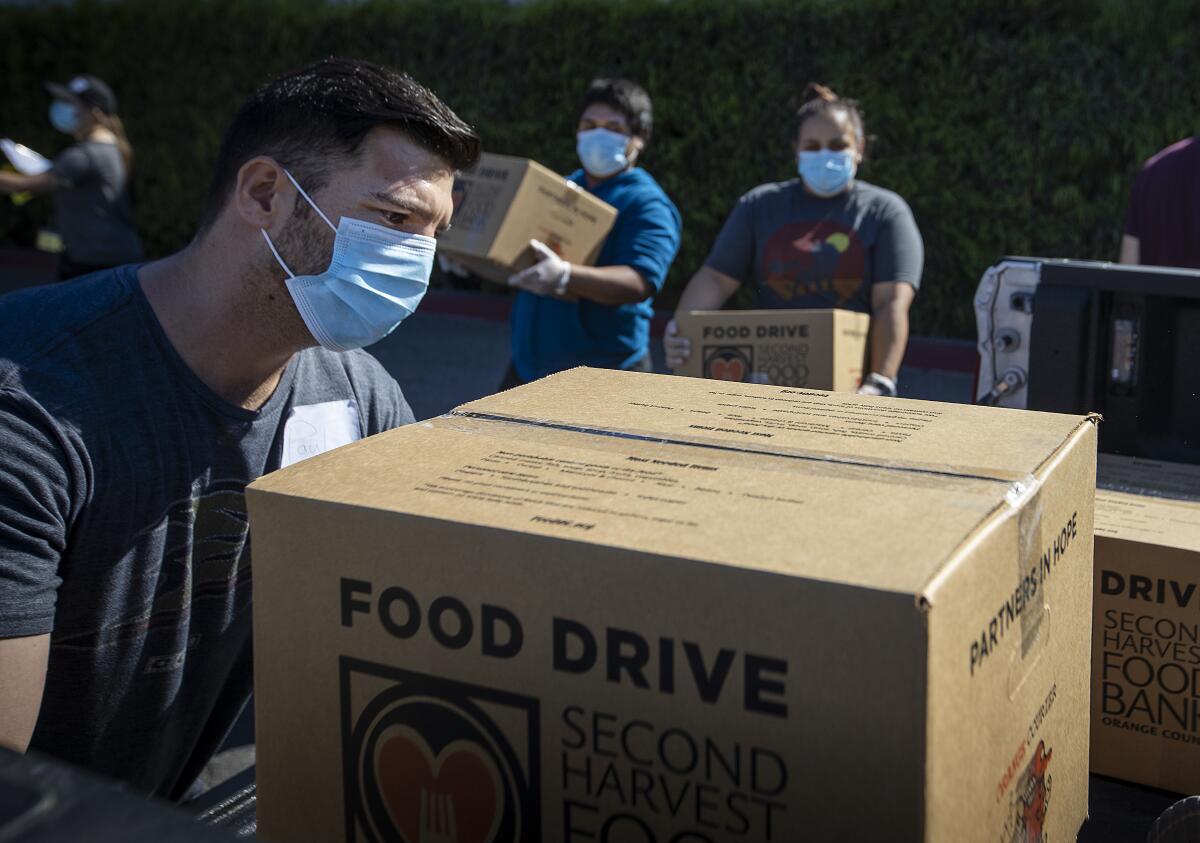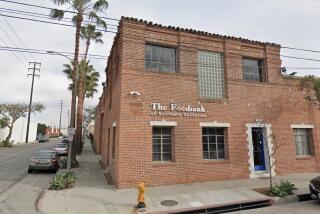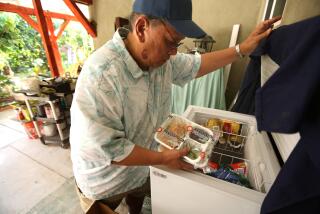How to help local food banks get needed supplies during the coronavirus pandemic

As the coronavirus pandemic continues to wreak havoc, food banks and pantries around Southern California are ramping up efforts to distribute large quantities of food to those who have lost jobs or income while adhering to social distancing guidelines.
The Los Angeles Regional Food Bank, which distributes food to about 600 agencies across the region, has seen a 49% increase in food distributed for each of the last two weeks compared with last year, said Chief Executive Michael Flood. Their food distribution last month set a new record.
The Salvation Army, which runs about 40 food pantries, has seen demand for food double since January.
“This is a disaster without edges,” said John Chamness, the divisional commander for the Salvation Army’s Southern California branch. “This is a disaster where you don’t know where it’s going to end.”
The World Harvest Food Bank in Arlington Heights has seen as many as 500 people each day on the weekends — double its usual traffic.
“We’ve got a line around the block,” said Glen Curado, the CEO.
The latest updates from our reporters in California and around the world
Find a food bank or pantry near you
Whether you’re looking for food, or looking to help, the Los Angeles Regional Food Bank has a comprehensive database of local pantries online. The organization partners with about 600 agencies to distribute food, although nearly 60 pantries have closed because of COVID-19. Flood said the organization is continuously updating the listings.
The Salvation Army also runs about 45 food pantries across Southern California. Locations can also be found online.
What is the greatest need right now?
When a disaster strikes, a food bank will usually coordinate a food drive, and they’ll see a surge in volunteers. But COVID-19 has put a wrench in both of those responses.
Flood said that because grocery stores have already been stressed by the pandemic, his organization isn’t asking people to go purchase groceries in person for donation. Instead, he said, a monetary donation can go a long way toward his agency purchasing food in bulk. The L.A. Regional Food Bank also relies on a patchwork of public and private donations for its inventory.
Curado said the World Harvest Food Bank has received an abundance of donations from local restaurants looking to offload inventory.
But, he said, his organization needs monetary donations to purchase an electric pallet jack to sort groceries.
Others said that many of the volunteers in the food pantry world are retirees who are at increased risk for complications with COVID-19. Local organizations are facing a shortage of volunteers as demand for food has surged.
If you’re healthy, consider volunteering to distribute food — while adhering to social distancing guidelines.
“The volunteer part of our network of work is the No. 1 issue right now,” Flood said.
The Salvation Army’s Chamness also said volunteering and cash donations are the best ways to support the organization right now. A monetary donation goes directly toward providing services. And as the agency handles more and more food volume, it needs people to help sort and distribute food. Each volunteer is provided masks and gloves.
“We want to make sure we’re safe,” Chamness said.
How to donate food and supplies
If you want to help a local pantry, call the organization to see what its needs are. Some might need more canned goods, for example; others may need diapers.
In-demand items include water, canned goods, peanut butter, jelly and canned fruit. Suggested nonfood items include hand-held can openers, toilet tissue, facial tissue, paper towels, hand sanitizer and grocery bags. Courier services such as Ziply are also accepting food bank donations so you don’t have to leave your house.
How to get help if you need food
Websites of the L.A. Regional Food Bank and the Salvation Army have listing for food banks and pantries. Second Harvest Food Bank is an option in Orange County.
The World Harvest Food Bank requests a $40 donation (cash, debit or EBT) or a four-hour volunteer shift in exchange for a cart of groceries. Other pantries have set hours where you can pick up food.
Flood also suggested applying for the CalFresh program, California’s food stamps program, which could provide assistance for groceries that, unlike at a food pantry, clients can choose.
More to Read
Sign up for Essential California
The most important California stories and recommendations in your inbox every morning.
You may occasionally receive promotional content from the Los Angeles Times.












